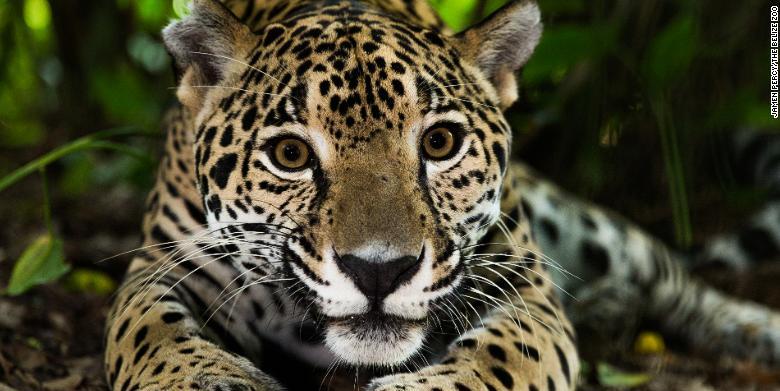
Reynold Carr showed off his tattooed arm.
Reynold Cal's forearm is engraved with black ink-colored Jaguar spots. On the left is the rose-shaped tattoo on Romeo's body, and on the right is the tattoo of Superman. Superman is the name Carl gave to jaguars after observing them over the years.
"Every jaguar has spots, but the spots on their bodies are unique," he said. "You just have to look at the jaguar's spots to identify it."
A descendant of the Mesoamerican Belizekk chima, Karl grew up in the forest and was fascinated by the jaguars that wandered through the forest. Today, his job is to track and protect jaguars and other species in nature reserves. Runaway Creek Nature Reserve, part of an important wildlife corridor in central Belize, is a rainforest reserve.
"The Maya have a high reverence for the jaguar — it's a symbol of royalty, power and power," he said. His grandfather told him to respect the mammal and never hunt it, and he remembers the fear of seeing jaguar footprints in the forest as a child. He added: "The reason I put these patterns (on my arms) is because I feel its connection to ancient history. ”。
But despite its long history, the future of the Jaguar remains uncertain. The International Union for Conservation of Nature (IUCN) says the numbers of these species are decreasing. The group lists these species as endangered, and habitat destruction is causing population divisions, which could lead to extinction of entire regions.
To avoid extinction, several animal protection groups — including the Runaway Creek Nature Reserve, the Jaguar, the Monkey Bay Wildlife Sanctuary, the Belize Zoo, the Wildlife Conservation Society and re:wild — have banded together to protect a piece of land within the jaguar's range: the Mayan Forest Corridor. The narrow area — less than 6 miles wide and 90,000 acres — is an important activity area for South America's largest cat.
"It's actually a connecting line between the two largest forests in Belize," said Elma Kay, biologist and managing director of the Mayan Forest Trust in Belize. She explained that due to deforestation and urban development, jaguars cannot travel between southern Belize and Guatemala, and use this corridor when they travel north to Mexico or south to Central or south to other parts of South America. It became a key link in the entire Jaguar campaign, which stretched for millions of square miles from Mexico to Argentina.
But Kay warned that "a small piece of land" was in danger of shrinking further. According to the Wildlife Conservation Society, deforestation to make way for agriculture such as sugar cane and cattle breeding has shrunk the Area of the Mayan Forest Corridor by more than 65 percent over the past 10 years.
Area in 2020
2010 annual area
Area in 2000
In recent decades, the Mayan Forest Corridor and its surrounding areas have suffered severe deforestation.
Emma Sanchez, coordinator of the Panthera Belize Jaguar Program, explains that this creates a barrier for big cats that need large forests to survive. "If an area is cut down, jaguars won't pass through it because... They may be killed, there may not be any prey in the areas where they are cut, or their water resources may be limited. ”。
Cutting off the jaguar's range of activity has huge consequences, she added, as all populations are linked through migration and reproduction. If a small population becomes isolated, it will lack genetic diversity and eventually die. "There are a lot of cases of species becoming extinct locally in different regions," she said.
Losing Jaguar can have a knock-on effect on your surroundings. As top predators, they create a balance in the ecosystem, limiting the number of species in the food chain below them. Sanchez said: "The conservation and conservation of jaguars also protects a larger landscape where we have different habitats and many other species. ”。
Protect jaguar habitat
As deforestation rates rise and time ticks, conservation groups decide that the fastest and most effective way to protect the Mayan forest corridor is to buy the land in them.
Late last year, they used funds raised by several global nature groups to secure 30,000 acres of protected land. This, combined with nearby nature reserves such as Runaway Creek, Monkey Bay and Land Managed by the Belize Zoo, brings the total area of the reserve to 42,000 acres, the size of Washington.
The Mayan Forest Corridor is located between the two largest wilderness regions in Central America. In recent years, people have developed the area, and highways have been built on it.
"We need to buy another 50,000 acres of land to complete the corridor connection," Kay said, "and the reality is that there isn't that much land available for purchase in the area." ”
She explained that some of the land is privately owned and that the rapid expansion of cities and agriculture in the region means that land acquisition is costly. Kay said the government approved the project in 2019 and local communities recognize the benefits of protecting nature as it will help provide sustainable livelihoods, water security and healthy soils.
A jaguar wanders through the Jungle of Belize and is captured by camera.
While the Mayan Forest Corridor Initiative has taken international action, Kay said conservation efforts are led by an indigenous Belizean. As a Belizean, "it makes me very proud," she added.
Carr agrees that indigenous respect for jaguars has always existed. He just hopes that jaguars will survive so that the younger generation can see them.
"They're amazing animals," he said. "They're very shy and it's hard to see them. But when you see the traces they've left behind, at least you know there's a jaguar nearby. ”